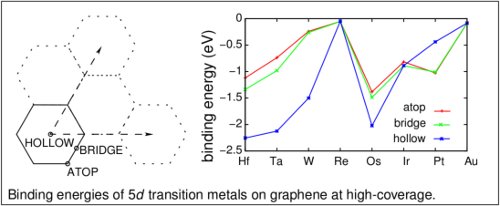Carbon nanostructures such as fullerenes and carbon nanotubes have been at the forefront of materials science for over two decades. Graphene with its two-dimensional honeycomb structure and
linear low-energy electron dispersion exhibits a host of interesting chemical and physical properties such as the quantum Hall effect and Klein tunneling, combined with a variety of possible
applications ranging from single molecule sensing to high electron mobility transistors. The
chemical modification of graphene through the addition of functional groups can lead to graphene
derivatives such as graphane with large application potential. In this work, we focus on a new
class of graphene derivatives, obtained by functionalizing graphene with transition metal atoms.
Our aim is to present a first-principles theoretical study of the binding energies of transition
metals spanning the 4d and 5d series in the limit of high-coverage. Transition metals are widely
used as substrates and contacts for graphene and carbon nanotubes. Au contacts are often used,
but other metals have been used and studied as well, such as Pt and Pd. As a guide to choosing
the optimal contacts in e.g. electrochemistry or electronic transport measurements, it is there-
fore of interest to understand which metals bind most strongly.

We have obtained a first-principles database of the binding energies of the 4d and 5d transition metals on a graphene sheet in the limit of high-coverage. We found that the metals at the end of the series such as Au and Ag bind weakest, while metals near the start of the series bind strongly, and the binding is strongest at the hollow sites. We found that the metals at the end of the series such as Au and Ag bind weakest, while metals near the start of the series bind strongly, and the binding is strongest at the hollow sites. We have shown that there is a minimal distortion of the graphene sheet and the functionalization is accompanied by a charge transfer from the transition metal to the graphene sheet; the charge transfer can be quite significant in the case of low occupation of the d shell. The strong binding of Ta suggests that Ta may be a good choice as a superconductor contact to graphene. The strong binding of graphene to Hf is retained even when graphene is deposited on the Hf rich (111) surface of cubic HfO2 , which opens up the possibility of interfacing graphene-based nanoelectronic components with silicon-based ones.
Publications on this topic
[1] Poster at IWEPNM'2010 (PDF).
[2] Zólyomi, V., Rusznyák, Á., Koltai, J., Kürti, J. and Lambert, C. J., "Functionalization of graphene with transition metals." In Phys. Status Solidi B, 247: 2920–2923 (2010) DOI.
[3] V. Zólyomi, Á. Rusznyák, J. Kürti, and C. J. Lambert, "First Principles Study of the Binding of 4d and 5d Transition Metals to Graphene." In The Journal of Physical Chemistry C 114 (43), 18548-18552 (2010) DOI.
Recent comments